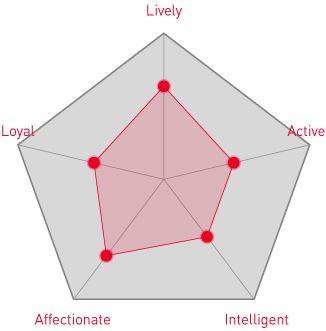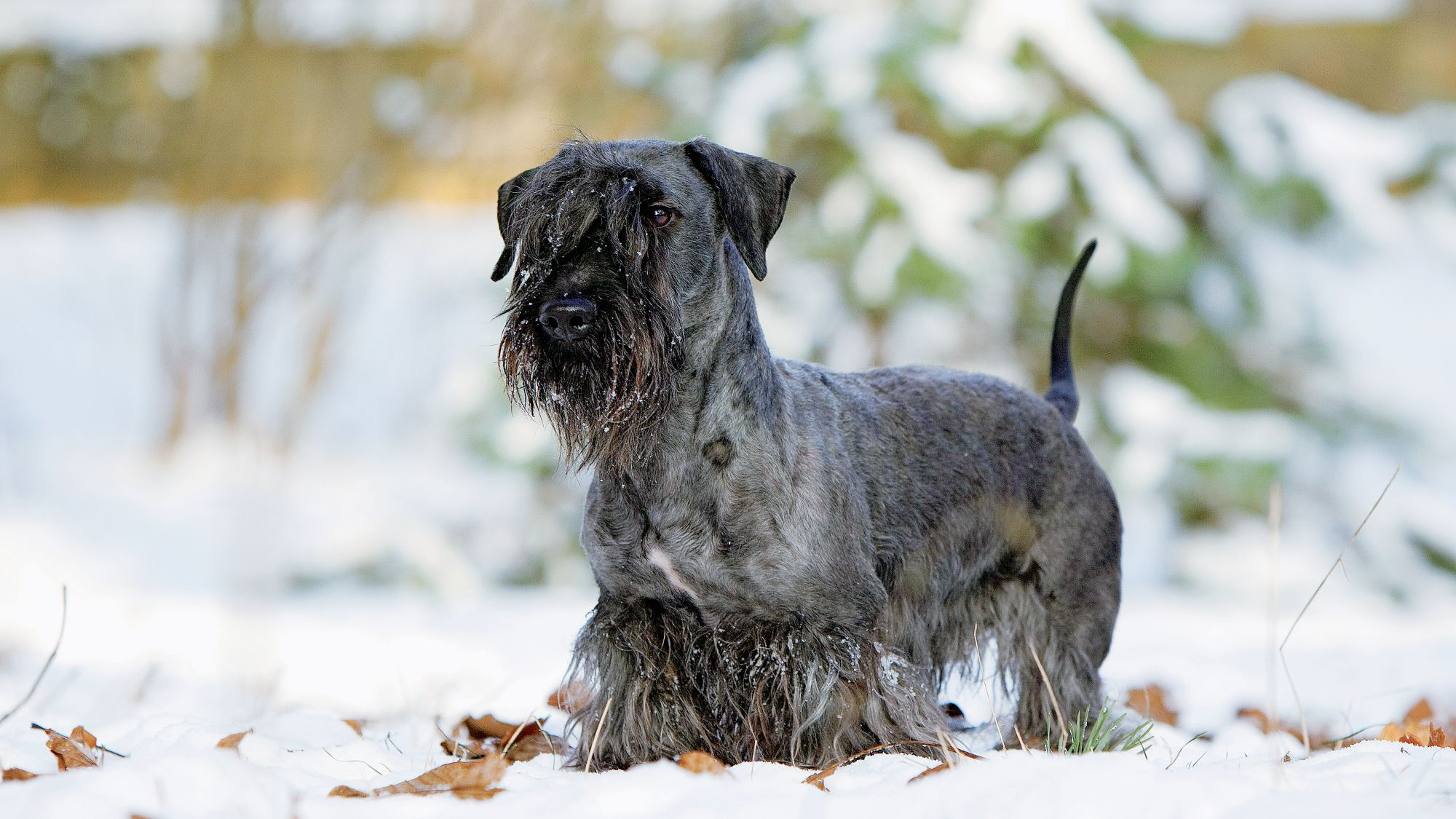
Let's talk Cesky Terriers
With an elongated body wrapped in silky fur and dashing facial hair on a charming wedge-shaped head, the Cesky Terrier is a conversation-starter at the dog park. The breed has a more balanced temperament than their fellow terriers, a plus for a group of dogs known for their gutsiness. Extremely devoted to their owners, Cesky Terriers adapt well to their living situation, whatever that might be. In their native country, the Czech Republic, the Cesky Terrier enjoys the rank of national dog. They are slightly harder to come by in the rest of the world.Official name: Cesky Terrier
Other names: Czech Terrier, Bohemian Terrier
Origins: Czech Republic

| Drooling tendencies: |
|
Warm weather? | |
| Shedding level: | Suited to apartment living? | ||
| Energy Level (high, low, medium) *: | Medium | Family pet?* |
 |
| Compatibility with other pets: | Can stay alone?* |  |
* We advise against leaving pets alone for long stretches. Companionship can prevent emotional distress and destructive behaviour. Speak to your veterinarian for recommendations.
Every pet is different, even within a breed; this snapshot of this breed’s specifics should be taken as an indication.
For a happy, healthy and well-behaved pet, we recommend educating and socialising your pet as well as covering their basic welfare, social and behavioural needs.
Pets should never be left unsupervised with a child.
All domestic pets are sociable and prefer company. However, they can be taught to cope with solitude from an early age. Seek the advice of your veterinarian or trainer to help you do this.


| Baby age: | Birth to 2 months |
| Puppy age: | 2 to 10 months |
| Adult age: | 10 months to 8 years |
| Mature age: | 8 to 12 years |
| Senior age: | From 12 years |

1/7
Get to know the Cesky Terrier
All you need to know about the breed
Fearless and feisty define the Cesky Terrier, a breed who is prized for their stamina as well as their top-drawer demeanour. They are a cross between the Scottish Terrier and the Sealyham Terrier, so a spirited dog for sure. The Cesky Terrier is more docile than other terrier breeds though, which makes for smoother sailing with family and other animal friends.
They are a terrier though so expect a certain amount of stubbornness and a high amount of drive. Bred as sport dogs, the Cesky Terrier breed may not tolerate small animals well – a trait that’s hard to shake – so be sure to train your Cesky Terrier from a young age to play nice. They are known as earthdogs, bred with a compact, elongated body to burrow into the earth after their charges.
Add their smarts and strength – and absence of aggression – and you’ve got one great dog. Their little-known status makes the Cesky Terrier hard to find outside of their native country: The breed is a beloved in their central European homeland, named the national dog of the Czech Republic.
The Cesky Terrier is extremely affectionate with their family including children, once they are trained around them. The breed uses their deep bark when stepping into their watchdog role, too, protecting their family above all if they sense strangeness afoot.

2/7
2 facts about Cesky Terriers
1. Mellower than most
Terriers are known to be determined, even high-strung, and the Cesky Terrier is no wallflower. They are though far less excitable than others in their group. The breed does have somewhat of a limit when it comes to other small pets so watch interactions closely, and keep all smaller beings secured. Training your Cesky Terrier early will help teach them tolerance when it comes to other household pets.
2. A scarcity problem
Some breeders have never even heard of them, so rare is the Cesky Terrier. Those who are eager to add this dog to their household may have a little trouble finding one: Although quite popular, and plentiful, in their native Czech Republic, there are only approximately 600 Cesky Terriers living in the United States, and they are hard to track down in many other countries as well. The Cesky Terrier remains in the top six of rare dog breeds worldwide.
History of the breed
A cherished dog in their native Czech Republic, it was around the middle of the 20th century that the Cesky Terrier came into prominence as a formal breed. The dog was the vision of Czech native František Horák, a breeder, geneticist, and sportsman who wanted to develop a dog that was well-behaved on the homefront but also a classic gritty terrier who could work in packs out in the field.
The Cesky Terrier was bred as a cross between a Sealyham Terrier and a Scottish Terrier. Originally bred for sport both above and below ground, Horák envisioned a dog who could be used in the forests outside Prague, which he knew well from his youth.
The Cesky Terrier was given official recognition by the Fédération Cynologique Internationale in 1963. They arrived on the shores of the United States in the late 1980s but were not admitted to the American Kennel Club until 2011.

4/7
From head to tail
Physical characteristics of Cesky Terriers
1. Ears
Ears set somewhat high, medium-sized, drooping.
2. Coat
Slightly wavy silky coat, well-tufted on bottom with signature fall and beard on head.
3. Body
Small and long well-muscled body characterised by short legs.

5/7
Things to look out for
From specific breed traits to a general health overview, here are some interesting facts about your Cesky Terrier

6/7
Caring for your Cesky Terrier
Grooming, training and exercise tips
Grooming the Cesky Terrier’s silky coat is a pleasure (it comes in several shades of gray, even a dazzling platinum). Many terriers are groomed by hand-stripping since their fur is usually wiry. Use clippers on the soft hair of the Cesky Terrier instead. Their coat doesn’t shed dirt easily so make sure to bathe your Cesky Terrier as needed. Include their charming facial hair and hair that grows in their ears (fairly profusely) when grooming, along with the Cesky Terrier’s nails and eyes. Clean their teeth daily, too. Exercise for the Cesky Terrier is a given. Luckily, they’re always up for a walk though their strong prey drive means keeping them on leash. When it comes to training the Cesky Terrier they’re as cooperative as they come. Highly intelligent and sensible, they respond best to firm yet kind commands but will shut down if they see discipline as too tough. If food rewards are involved? They’ll willingly trade a task for a treat, taken from their daily kibble portion, of course.7/7
All about Cesky Terriers
If the Cesky Terrier is the breed for you, finding them outside the Czech Republic could prove challenging. They’re rare, ranked by the American Kennel Club 185th out of 197 breeds. Immensely popular in their native country, they’re one of the few terrier breeds developed outside of the British Isles, with only a few hundred found in the United States.
The Cesky Terrier is known for their deep, low bark however a dog found more on the homefront may differ from those out in the great outdoors. Most terrier breeds were developed to alert their owners that they found something interesting, so the inclination to use their voice is instinctual. Like any breed, make sure you train your Cesky Terrier from the get-go so they use their inside voice as much as possible.
translations.feature.breeds.otherbreeds
Read more on this topic

How your dog's nutrition needs change with age

How to adopt a dog

Things to consider before getting a dog
Sources
1 - Veterinary Centers of America https://vcahospitals.com/
2 - Royal Canin Dog Encyclopaedia. Ed 2010 and 2020
3 - Banfield Pet Hospital https://www.banfield.com/
4 - Royal Canin BHN Product Book
5 - American Kennel Club https://www.akc.org/



